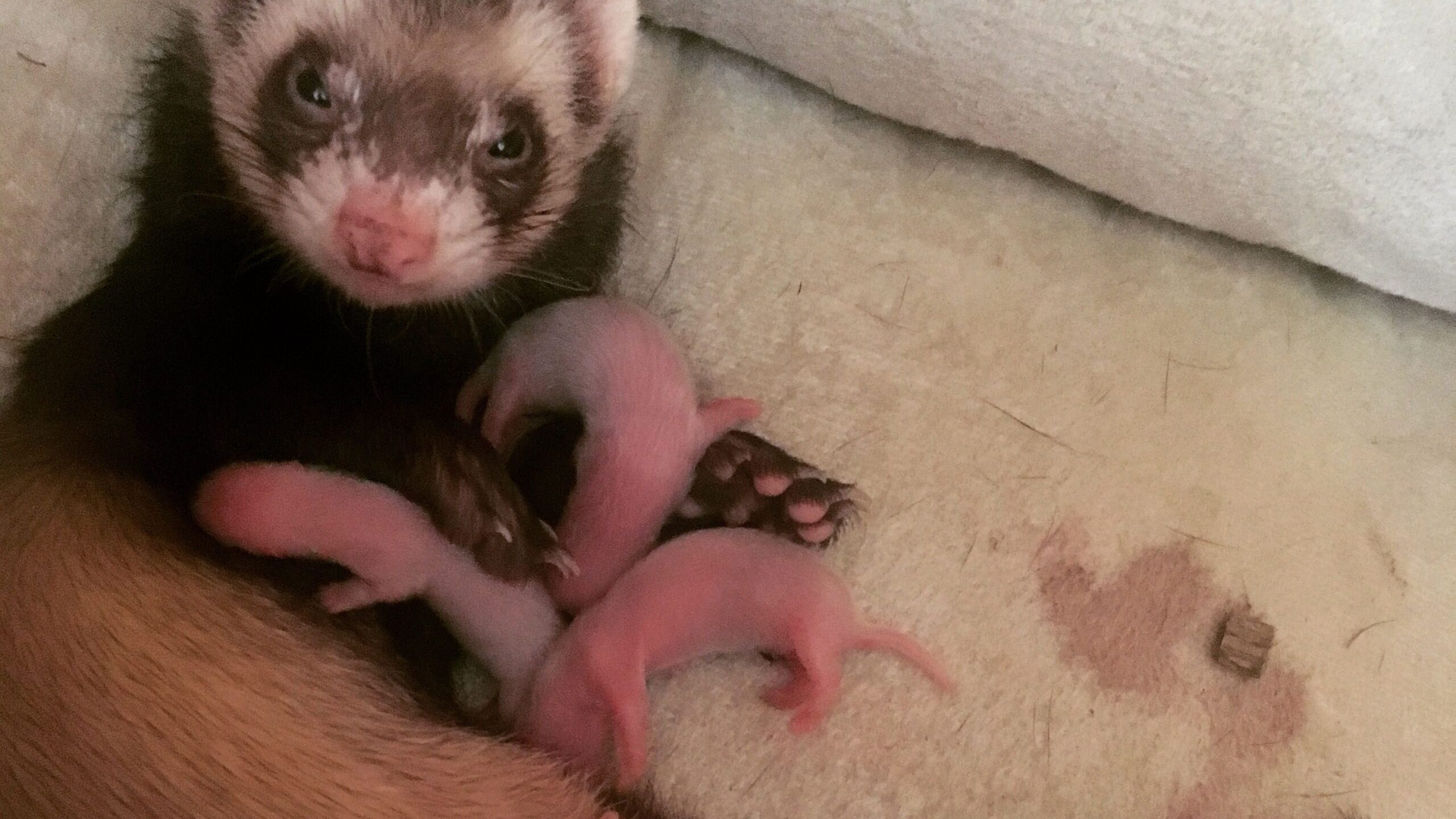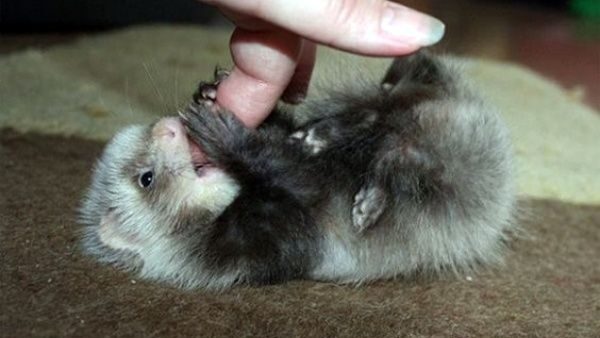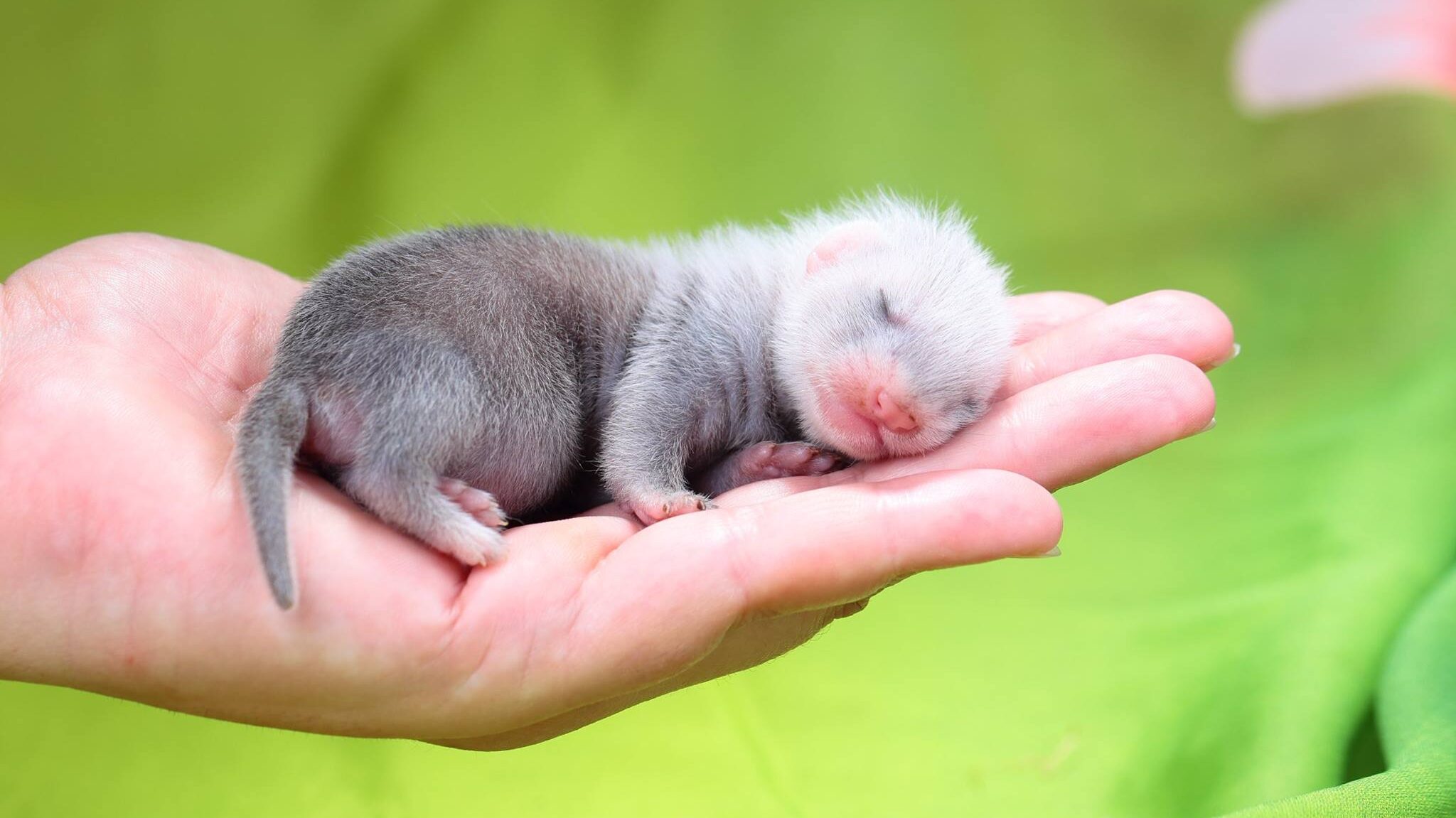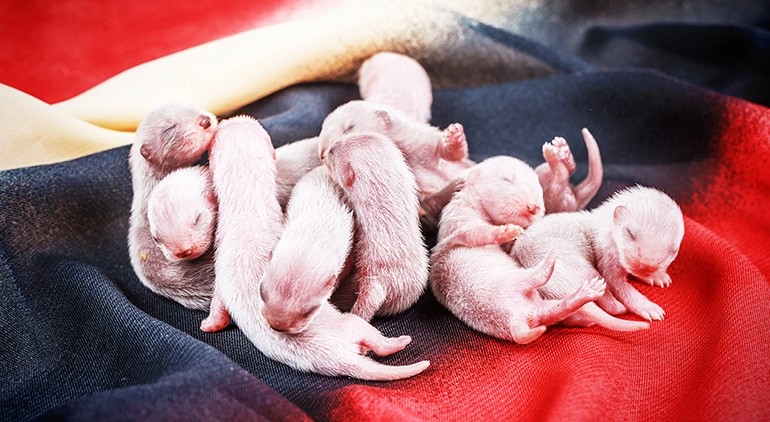Baby ferrets are adorable, but there’s so much more to them than just looking cute! If you’re just curious about ferret babies, read on for plenty of fun facts. If you’ve found yourself as the new owner of a baby ferret, though, we’ve also got special care information you need to know!
There’s a lot to learn about baby ferrets, so we’re dividing this post up into two main sections. The first section will be comprised on baby ferret facts, and the second section will the life stages of a ferret kit!
Table of Contents
Baby Ferret Facts and Trivia
Many of you have probably seen a picture of a baby ferret and wanted to learn more about them. You’re in the right place!
What Are Ferret Babies Called?
Ferret babies, or ferrets that are less than a year old, are called kits.
They also have another name, and this one changes based on their gender and whether or not they’re fixed. Intact males are called hobs, while neutered males are called gibs. Intact females, on the other hand, are called jills, while spayed females are called sprites.
How Many Babies Do Ferrets Have?
After a gestation period of about 42 days, mother ferrets, or Jills, typically have litters of between 3 and 7 baby ferrets. However, some litters can have up to or more than 14 babies, while others just have 1!
The average amount of kits per litter is a result of hundreds of years of evolution. Smaller litters have less of a chance to survive until adulthood, while larger litters are difficult for the mother to care for and feed due to a lack of nipples. With ferret breeders being able to care for a jill’s babies, though, larger litters are becoming more common.
What Do Ferrets Look Like When They’re Born?
Brand new baby ferrets are a sight to behold, weighing between 6 and 14 grams and topping out at about 2/5 inches in length, including their tail. All baby ferrets are born without fur, and when fur does start to come in, it’s always plain white. They’re also blind, deaf, and have no teeth!
Only after about 3 weeks or so do baby ferrets start to really develop. Not only does their fur get longer and start to develop hints of their true colors, but they also start to develop their teeth, eat solids, and develop their trademark ferret musk.

How Much Do Baby Ferrets Cost?
Ferrets are typically offered for sale at around 8-10 weeks of age at the youngest, so unless you’re breeding them yourself, you’re unlikely to get to own an actual “baby” ferret. This definitely isn’t a bad thing, though, as ferrets 2 months or younger should only be cared for by professionals.
With that said, baby ferrets typically cost between $100 and $200, with shelters and pet stores being on the lower end of that range and breeders being at the higher end. In fact, breeders can charge $300+ for a kit depending on their reputation and the ferret’s type/pedigree.
Ferret Guide, along with all ferret experts, highly recommend that you first turn to a shelter or rescue to adopt a ferret. There are many ferrets waiting for a second chance with a new owner, and it’s always better to to care for existing ferrets than supporting bringing new ferrets into the world.
With that said, the baby ferret isn’t the only cost you’ll incur. There are quite a few initial costs you’ll incur like a cage, litter box, and toys, as well as ongoing costs like food, litter, and vet visits. Our post How Much Does a Pet Ferret Cost covers this topic in detail.
What Do Baby Ferrets Eat?
When they’re first born, baby ferrets nurse off of their mother. Because of this dependance on the jill, if milk stops being produced for whatever reason or if there’s too many ferrets for the jill to feed, the smallest, weakest baby ferrets can unfortunately die.
At between 3 and 4 weeks, baby ferrets start to eat solid foods in addition to nursing. They’re typically fed water or broth-soaked kitten food that’s high in protein, as ferrets in this key growth stage need as much protein as possible. At about 6 weeks of age, ferrets are entirely weaned off of their mothers.
Like ferrets of all ages, and as highlighted in our post What to Feed Your Pet Ferret, kits can not eat fruits, vegetables, or grains. They are obligate carnivores, meaning that they get all of their nutrients from animal flesh.
Can Baby Ferrets Be Trained?
Baby ferrets are at the perfect age to learn good behaviors, such as how to use their litter box! Once a ferret learns a way to do something, especially if they receive positive reinforcement, they’re not likely to change their ways. This is why litter training for the first 2-3 weeks after getting your new baby ferret is so important.
Aside from litter training, teaching your kit not to bite is another pivotal task. Ferrets are nippy, especially kits, so it’s important to “nip” that behavior in the bud. Lastly, you can train your ferret at this age to follow some basic commands, like coming when called or standing up for a treat.

Common Baby Ferret Illnesses
Baby ferrets are particularly susceptible to several different illnesses as their immune systems are still developing, and they’re also being exposed to several new environments in a short period of time.
- Ear Mites
- Ear mites are common problems for baby ferrets, and can be picked up from other ferrets or other animals that your ferret comes in contact with.
- Respiratory Infections
- There are several different types of respiratory infections that baby ferrets are susceptible to, and stress and poor husbandry conditions are significant contributing factors.
- Prolapsed Rectum
- This problem typically occurs in ferrets between the ages of 2 and 6 months, and can be caused by a plethora of factors.
- Eye Conditions
- Affecting ferrets of all ages, eveitis is a condition that’s often a result of trauma to the eye, resulting in an infected wound and eye discharge.
The Stages of a Baby Ferret’s Development
Baby ferrets grow up quick, with new developments happening nearly every week! We’ve broken down exactly what happens throughout a ferret’s life as a kit. For weights mentioned, please note that those are general ranges, and hobs (males) are usually larger than jills (females)
Week 1
Weight: 6 to 25 grams
Appearance: At birth, ferrets have very little to no fur and no teeth, and they’re also blind and deaf. These brand new babies are 2.5 inches in length maximum, from their nose to the tip of their tail. They have soft pink skin that’s especially visible on their nose, ears, and mitts.
Behavior: Since these ferrets are blind and deaf, they can’t do much beyond sleep and nurse off of their mother every couple of hours. They’re entirely dependent on their mother for food, cleaning after defecating, and being kept close by when they try to wander off.
Week 2
Weight: 20 to 35 grams
Appearance: Thanks to their constant feeding, baby ferrets get noticeably larger after a week, with their fur starting to grow a bit longer.
Behavior: Babies are still fully dependent on their mothers, with their days consisting of eating and nursing.
Week 3
Weight: 50 to 90 grams
Appearance: Ferrets are now about quadruple the size they were 2 weeks ago. Their hair is starting to darken up and show signs of what their adult colors will be. They’ll also start to develop their teeth around this age.
Behavior: Ferrets around this age will start to eat solid foods consisting of ground/boiled meat and broth-soaked kibble — high-protein meat-based foods. As they’ve been nursing up until this point, 3 week old ferrets are extremely messy eaters, getting more food on them than in them!

Week 4
Weight: 100 to 150 grams
Appearance: In their fourth week, ferrets really start to change how they look thanks to the solid food they’re now consuming. Some kits will have their eyes and ears open around this time, and their fur’s coloration is becoming much more developed. Light roan, champagne, and chocolate stay quite light, while sables keep a light gray head and darker gray body. Their teeth are also nice and sharp.
Behavior: Baby ferrets will now be quite good at eating solid foods, taking little time to eat their fill. They’ll also start to become vocal, making what’s typically referred to as a honking noise to communicate with their mother. Ferrets will also start to play with each other, and the task of litter training is typically undertaken.
Week 5
Weight: 160 to 220 grams
Appearance: Getting larger still, ferrets in their fifth week have very prominent colors and will definitely have open eyes and ears.
Behavior: Play is a lot more common now that every ferret is more nimble on their feet and can see the world around them. Any training attempts should be well underway, such as using the litter box and not nipping.
Week 6
Weight: 240 to 250 grams
Appearance: At this stage, ferrets will start to look like miniature versions of their adult selves, with large (but not yet adult) teeth and more prominent coloration.
Behavior: Ferrets around 6 weeks old will be fully weaned off of their mothers and stop nursing. Playing and overall movements become much faster, and sleeps get more intense, with ferrets falling into deep sleeps called “dead sleeps”.
Week 10
Weight: 600 to 800 grams
Appearance: By this age, ferrets weigh about half, or slightly less than half, of their fully-grown weight. Baby teeth will have fallen out and been replaced by larger adult teeth. Fur and pattern development should be about complete.
Behavior: Ferrets are generally ready to be purchased by a loving family around this time. Good behaviors, like using the litter box and not biting, are generally well-established. At this point, you’re well aware how your ferret is going to act when it’s older!
